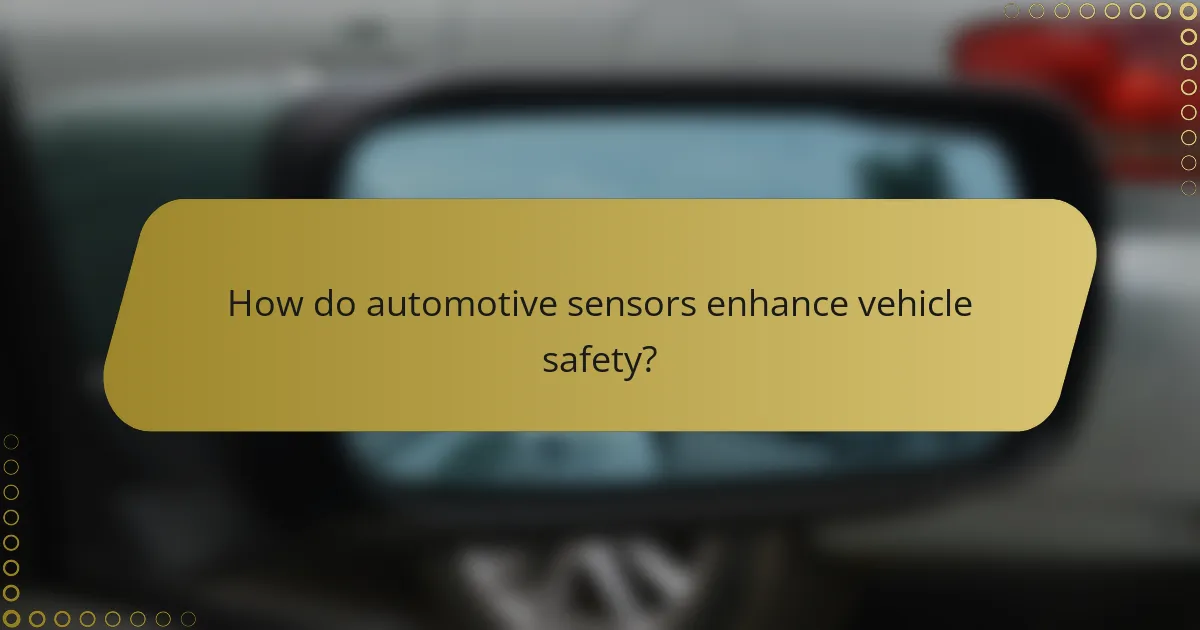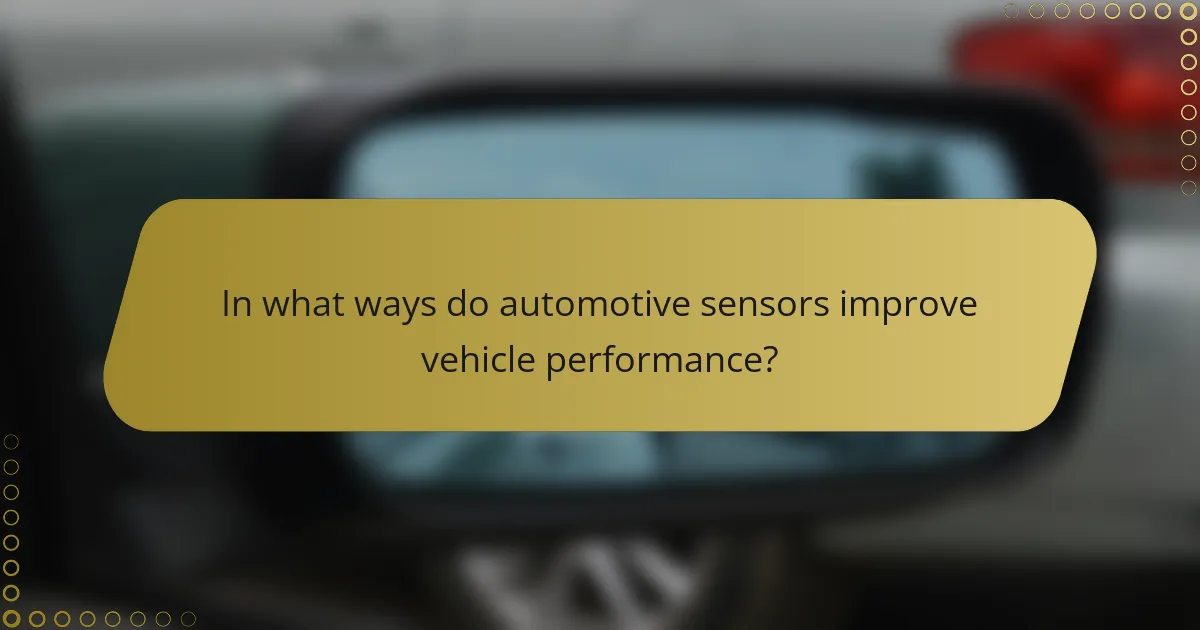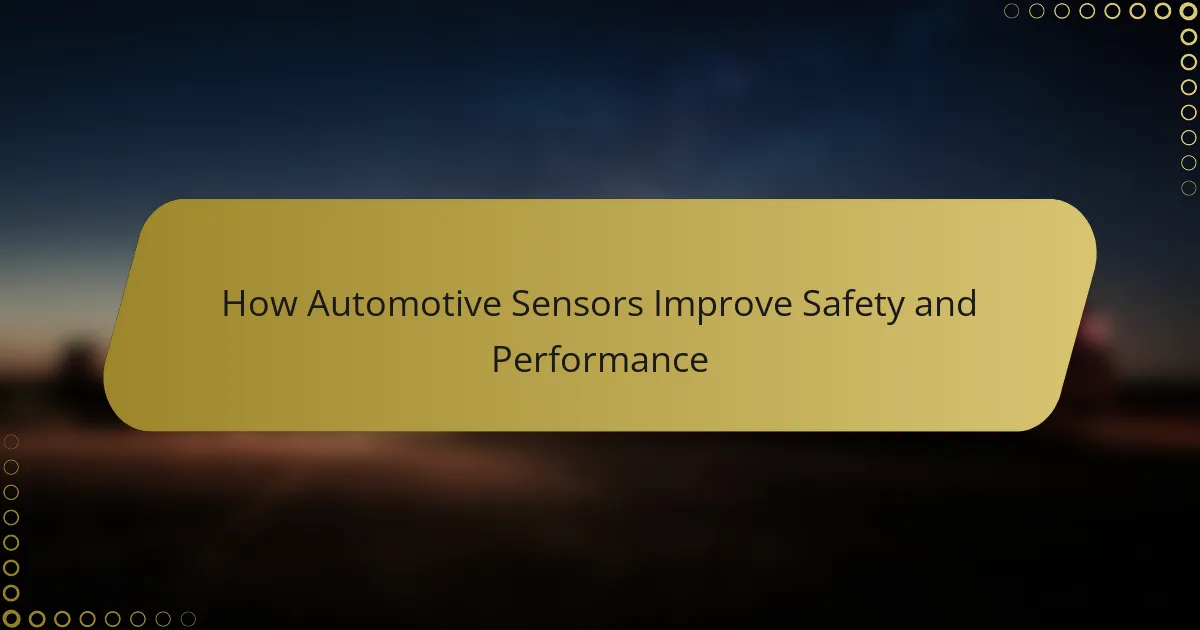Automotive sensors are critical components that enhance vehicle safety and performance by providing real-time data for various functions. These sensors detect conditions such as proximity to obstacles, vehicle speed, and driver behavior, contributing to accident prevention and improving overall driving efficiency. Advanced driver-assistance systems (ADAS) utilize data from multiple sensors, including radar and cameras, to optimize safety features like adaptive cruise control and lane detection. The article also explores future trends in sensor technology, including the integration of artificial intelligence, miniaturization, and the development of robust sensors for electric and autonomous vehicles, all aimed at enhancing vehicle capabilities and ensuring reliable operation in diverse conditions.

How do automotive sensors enhance vehicle safety?
Automotive sensors enhance vehicle safety by providing real-time data that assists in accident prevention. These sensors detect various conditions such as proximity to obstacles, vehicle speed, and driver behavior. For instance, radar sensors can monitor the distance to other vehicles, allowing for adaptive cruise control. Cameras can identify lane markings and detect pedestrians. Additionally, sensors like tire pressure monitors alert drivers to potential issues before they lead to accidents. According to the National Highway Traffic Safety Administration, vehicles equipped with advanced driver assistance systems reduce crash rates significantly. This data supports the effectiveness of automotive sensors in enhancing overall vehicle safety.
What types of automotive sensors are used for safety improvements?
Automotive sensors used for safety improvements include collision sensors, lane departure warning sensors, and parking sensors. Collision sensors detect imminent crashes and activate safety systems. Lane departure warning sensors monitor lane position and alert drivers when drifting. Parking sensors assist in detecting obstacles while reversing. Additionally, adaptive cruise control sensors maintain safe distances from other vehicles. These sensors enhance vehicle safety by providing real-time data and alerts to drivers. Studies show that vehicles equipped with these sensors significantly reduce accident rates. For instance, the Insurance Institute for Highway Safety reported a 14% reduction in rear-end collisions due to collision avoidance systems.
How do collision detection sensors work to prevent accidents?
Collision detection sensors work by using various technologies to identify potential obstacles. These sensors typically employ radar, lidar, or cameras to monitor the surrounding environment. When an object is detected within a certain range, the system assesses the risk of collision. If a potential accident is imminent, the sensors trigger warnings for the driver. In some cases, the system can automatically engage brakes or alter vehicle speed to prevent an accident. Studies show that vehicles equipped with collision detection systems can reduce accident rates significantly. For example, the Insurance Institute for Highway Safety reports that such systems can lower rear-end collisions by up to 40%.
What role do lane departure warning sensors play in safety?
Lane departure warning sensors enhance safety by alerting drivers when they unintentionally drift from their lane. These sensors use cameras and sensors to monitor lane markings on the road. When a vehicle begins to veer without signaling, the system activates visual or audible warnings. This prompt helps prevent potential accidents caused by lane drifting. According to the National Highway Traffic Safety Administration, lane departure warning systems can reduce crashes by 11%. This statistic underscores their effectiveness in improving road safety.
Why is real-time data from sensors crucial for safety?
Real-time data from sensors is crucial for safety because it enables immediate responses to potential hazards. These sensors monitor various conditions such as speed, braking, and environmental factors continuously. They provide instant feedback to the vehicle’s systems, allowing for timely interventions. For example, adaptive cruise control uses real-time data to adjust speed based on traffic conditions. According to a study by the National Highway Traffic Safety Administration, vehicles equipped with advanced sensor systems can reduce collision rates by up to 40%. This illustrates the effectiveness of real-time data in enhancing safety measures.
How does real-time data processing contribute to accident avoidance?
Real-time data processing significantly contributes to accident avoidance by enabling immediate analysis of sensor inputs. This processing allows vehicles to detect potential hazards, such as sudden stops or obstacles, in real-time. For instance, systems like Automatic Emergency Braking utilize data from radar and cameras to assess the environment. When a potential collision is identified, the system can react faster than a human driver. Research shows that such systems can reduce the likelihood of rear-end collisions by up to 40%. Additionally, real-time data processing supports adaptive cruise control, maintaining safe distances from other vehicles. This proactive approach to safety enhances overall vehicle performance and driver awareness.
What are the implications of delayed sensor data on safety?
Delayed sensor data can significantly compromise safety in automotive systems. It can lead to slower response times in critical situations. For instance, if a vehicle’s collision detection sensor is delayed, the braking system may not engage in time. This increases the risk of accidents and injuries. Studies show that timely data processing can reduce collision rates by up to 30%. Furthermore, delayed data can disrupt communication between safety systems, leading to potential system failures. Accurate and immediate sensor data is essential for effective decision-making in real-time driving scenarios.

In what ways do automotive sensors improve vehicle performance?
Automotive sensors enhance vehicle performance by providing real-time data for critical systems. They monitor engine parameters, optimizing fuel efficiency and power output. For instance, oxygen sensors adjust air-fuel mixtures for better combustion. Tire pressure sensors maintain optimal tire pressure, improving handling and fuel economy.
Additionally, temperature sensors regulate engine cooling, preventing overheating and ensuring efficient operation. Speed sensors provide accurate vehicle speed readings, enhancing stability and control. Advanced driver-assistance systems (ADAS) utilize sensors to improve safety and performance through features like adaptive cruise control.
Research shows that vehicles equipped with multiple sensors can achieve up to 15% better fuel efficiency compared to those without. This data-driven approach leads to more responsive and efficient driving experiences.
What specific performance metrics are enhanced by automotive sensors?
Automotive sensors enhance several specific performance metrics. These include vehicle speed, fuel efficiency, and engine performance. Sensors monitor tire pressure, improving safety and handling. They also track emissions, ensuring compliance with regulations. Additionally, sensors contribute to adaptive cruise control, enhancing driver convenience. Collision detection systems utilize sensors to improve safety metrics. Data from sensors aids in predictive maintenance, optimizing vehicle reliability. Overall, automotive sensors play a crucial role in enhancing these performance metrics.
How do engine performance sensors optimize fuel efficiency?
Engine performance sensors optimize fuel efficiency by providing real-time data to the engine control unit (ECU). These sensors monitor various parameters such as air-fuel ratio, engine temperature, and throttle position. The ECU uses this data to adjust fuel injection and ignition timing. This optimization ensures the engine operates at its most efficient level. For instance, a study found that precise air-fuel ratio adjustments can improve fuel economy by up to 15%. Additionally, sensors like the Mass Air Flow (MAF) sensor directly influence fuel delivery based on air intake measurements. By continuously monitoring and adjusting these parameters, engine performance sensors significantly enhance overall fuel efficiency.
What impact do tire pressure sensors have on vehicle handling?
Tire pressure sensors significantly enhance vehicle handling. They monitor tire pressure in real-time. Proper tire pressure ensures optimal contact with the road. This improves traction and stability during driving. Under-inflated tires can lead to poor handling and increased stopping distances. Over-inflated tires can cause a harsh ride and reduced grip. Studies show that maintaining correct tire pressure can improve fuel efficiency by up to 3%. Thus, tire pressure sensors contribute to safer and more efficient vehicle operation.
How do automotive sensors contribute to overall vehicle reliability?
Automotive sensors enhance vehicle reliability by providing real-time data for critical systems. They monitor parameters such as engine temperature, tire pressure, and fuel levels. This data allows for timely maintenance and alerts drivers to potential issues. For instance, tire pressure sensors can prevent blowouts by alerting drivers when pressure is low. Engine sensors help optimize performance and fuel efficiency, reducing wear and tear. According to the National Highway Traffic Safety Administration, proper tire pressure can improve fuel efficiency by up to 3%. Overall, the integration of these sensors leads to proactive maintenance and increased vehicle longevity.
What types of diagnostic sensors are essential for vehicle maintenance?
Essential diagnostic sensors for vehicle maintenance include oxygen sensors, mass airflow sensors, and throttle position sensors. Oxygen sensors monitor the exhaust gases to optimize fuel efficiency and emissions. Mass airflow sensors measure the amount of air entering the engine for precise fuel delivery. Throttle position sensors track the position of the throttle valve, ensuring proper engine performance. Additionally, coolant temperature sensors provide vital information about engine temperature for effective cooling system management. These sensors are crucial for diagnosing issues and maintaining optimal vehicle performance.
How can sensor data predict potential mechanical failures?
Sensor data can predict potential mechanical failures by monitoring real-time conditions of vehicle components. Sensors track variables such as temperature, vibration, and pressure. Abnormal readings in these metrics often indicate wear or malfunction. For example, increased vibration levels can suggest issues with bearings or misalignment. Predictive analytics can process this sensor data to identify patterns linked to past failures. Historical data enhances model accuracy, allowing for timely maintenance alerts. Studies show that predictive maintenance can reduce downtime by up to 30%. This proactive approach minimizes repair costs and enhances vehicle safety.

What are the future trends in automotive sensor technology?
Future trends in automotive sensor technology include increased integration of artificial intelligence and machine learning. These technologies enhance the processing capabilities of sensors, allowing for real-time data analysis. Advanced driver-assistance systems (ADAS) will rely more on multi-modal sensors, combining data from cameras, LiDAR, and radar. This integration improves vehicle perception and decision-making.
Moreover, the trend towards miniaturization of sensors is evident. Smaller sensors can be placed in more locations, increasing data collection without compromising vehicle design. Wireless sensor networks are becoming more common, enabling seamless communication between vehicles and infrastructure. This connectivity enhances safety by providing timely information to drivers.
Another trend is the development of more robust sensors capable of operating in harsh environments. These sensors will ensure reliability in diverse weather conditions. Additionally, sensor fusion techniques are gaining traction. They combine data from various sensors to create a comprehensive understanding of the vehicle’s surroundings. This approach improves accuracy and reduces the likelihood of false positives.
The push for electric and autonomous vehicles is driving innovation in sensor technology. These vehicles require advanced sensors for navigation and obstacle detection. As the automotive industry evolves, sensor technology will play a crucial role in enhancing safety and performance.
How is the integration of AI changing automotive sensor capabilities?
The integration of AI is significantly enhancing automotive sensor capabilities. AI algorithms improve data processing and interpretation from sensors. This leads to more accurate real-time decision-making. Enhanced sensor capabilities enable advanced driver-assistance systems (ADAS). These systems improve vehicle safety by predicting potential hazards. For example, AI can analyze data from cameras and radar to detect pedestrians. According to a study by McKinsey, AI can reduce accidents by up to 20%. This demonstrates the effectiveness of AI in automotive sensor technology.
What advancements are being made in sensor accuracy and responsiveness?
Advancements in sensor accuracy and responsiveness include improved algorithms and enhanced materials. These developments enable sensors to provide more precise data in real-time. For instance, LiDAR technology has seen significant enhancements, resulting in better object detection and distance measurement. Additionally, machine learning algorithms are being integrated, allowing sensors to adapt to varying environmental conditions. Research shows that these advancements can reduce error rates by up to 30%. Furthermore, advancements in semiconductor technology are leading to faster signal processing. This results in quicker response times, crucial for applications like automatic braking and collision avoidance. Overall, these innovations significantly enhance the safety and performance of automotive systems.
How will future sensors enhance autonomous vehicle safety and performance?
Future sensors will enhance autonomous vehicle safety and performance by providing more accurate environmental data. These sensors include advanced LIDAR, radar, and camera systems. They enable vehicles to detect obstacles and pedestrians more effectively. Enhanced data processing allows for quicker decision-making. Improved sensor fusion techniques integrate information from multiple sources. This results in a comprehensive understanding of the vehicle’s surroundings. Studies show that vehicles equipped with advanced sensors reduce accidents by up to 40%. Enhanced sensors also improve navigation accuracy in complex environments. This leads to better route planning and fuel efficiency.
What best practices should drivers follow regarding automotive sensors?
Drivers should regularly check and maintain automotive sensors to ensure optimal performance. Regular inspections help identify issues before they affect vehicle safety. Keeping sensors clean is essential, as dirt can impair functionality. Drivers should also be aware of warning lights on the dashboard related to sensor malfunctions. Following the manufacturer’s guidelines for sensor calibration is crucial for accurate readings. Additionally, using diagnostic tools can help in assessing sensor health. Properly functioning sensors contribute to improved vehicle safety and performance. Research indicates that well-maintained sensors can reduce accident rates by enhancing driver awareness.
How can regular maintenance of sensors improve vehicle safety and performance?
Regular maintenance of sensors enhances vehicle safety and performance by ensuring accurate data collection. Sensors monitor critical systems, including braking, stability, and engine performance. When these sensors function properly, they provide real-time information to the vehicle’s control systems. This leads to timely responses in safety features, such as anti-lock braking systems and traction control. Regular maintenance helps identify and rectify sensor malfunctions before they lead to failures. For instance, a study by the National Highway Traffic Safety Administration found that properly functioning sensors can reduce accident rates by up to 30%. Therefore, routine checks and calibrations are essential for optimal sensor performance and overall vehicle safety.
What signs indicate that automotive sensors may need attention or replacement?
Signs that automotive sensors may need attention or replacement include warning lights on the dashboard. These lights often indicate sensor malfunctions. Unusual engine performance can also signal sensor issues. For example, poor acceleration or stalling may be linked to malfunctioning sensors. Additionally, decreased fuel efficiency can suggest that sensors are not functioning properly. Erratic behavior of vehicle systems, like inconsistent speed readings, is another indicator. Finally, diagnostic trouble codes retrieved from the vehicle’s computer can confirm sensor problems. Regular checks can help identify these issues early.
The main entity of this article is automotive sensors, which play a crucial role in enhancing vehicle safety and performance. The article explores how these sensors provide real-time data to prevent accidents, improve handling, and optimize fuel efficiency. Key topics include the types of sensors used for safety improvements, the mechanisms behind collision detection and lane departure warnings, and the importance of real-time data processing. Additionally, the article discusses the impact of sensor maintenance on vehicle reliability and outlines future trends in automotive sensor technology, including advancements in AI integration and sensor accuracy.
